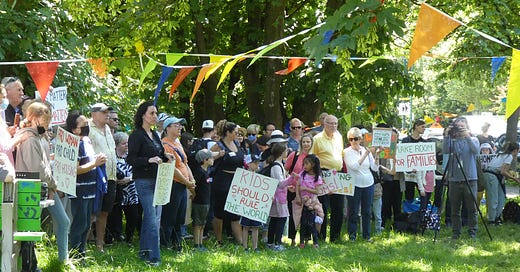For those we will not hear…and those we hope will listen
City Conversation #60: The science and facts against this proposal are suppressed, but decisive—will Council listen?
June 28, 2022—What follows are my lightly edited remarks at the first of several evenings of the public hearing for a proposed high-rise low barrier residential spot rezoning development at 8th & Arbutus—I have added a bit of relevant data released by the Kitsilano Coalition spokesperson at her presentation regarding the deliberate destruction of scientific data that do not support this proposal. Please read to the bottom, where I write about how, with your involvement, this time we can make a difference.
The community came together to rally against this proposal—but is that enough?
“I am speaking in opposition to the proposed spot rezoning at 8th and Arbutus. There are three reasons for my opposition to this proposal:
1. There is no independently peer-reviewed science supporting successful outcomes for this many folks with this many issues in this form of housing. Independently peer-reviewed science is an important concept here—it means data-based and objective rather than self-reported or subjective. By now there should be much independently peer-reviewed science (hereafter just science), but the provincial government shut down the funding of research in this area. In fact, the provincial government demanded that Dr. Julian Somers of Simon Fraser University destroy 17 years of such scientific data as soon as they cut his funding. Dr. Somers will speak later in the queue about his findings as they relate to this proposal.
2. The science that does exist supports a more distributed approach—fewer folks in each of many more facilities, with many more supports—an approach with real hope for improving the lives of all affected and better integrating with the neighbourhood.
3. My Homes for Whom database, which includes spot rezoning data suppressed by city staff, shows that the city has already completed spot rezoning of more than 11,000 rental homes that have not yet been built, plus over 20,000 rental homes that are in the current approvals queue, plus at least 12,000 rental homes contemplated in projects like Senakw’ and the Jericho Lands. That’s 43,000 rental homes, of which a small percentage could be distributed homes for the folks currently slotted into 8th and Arbutus.
Others will talk more knowledgeably than I about the science around more widely distributed supportive housing as compared with the approach proposed for this site, involving as it does the de facto warehousing of 129 people in metal micro-suites that cannot ever be adapted to house couples or families together.
One of the few permanent projects in the city anywhere close to the size of this project and with similar resident composition is the Marguerite Ford project, 147 homes in a high-rise format opened in 2013 near Olympic Village. Vancouver Police Department data about 911 calls to the area of this project shows that as compared to the average of calls in the two years preceding its opening, 911 calls increased 1700% in the two years from its opening. Various non-scientific folks, including the provincial Minister for Housing, David Eby, have assured Council and residents that after a settling in period all will return to normal. This does not explain why it is that eight years after the opening of the Marguerite Ford project, this area still receives 1500% more 911 calls than it did before the project opened.
Another comparison supporters of this project, including Minister Eby, make is to the Sanford Apartments at Fir & 7th Avenue in Vancouver. It’s less than half the size of this proposal (62 homes versus 129) in a slightly shorter high-rise than this proposal and not too far east of it, so on paper a good comparison, especially as it is operated by the same folks as proposed for this project, MPA. Except Sanford is not low-barrier housing—it allows no drug use, unlike this proposal. When questioned, MPA confirmed they have never operated a project of this size or composition. The fact that Minister Eby has specifically referred to this project in his don’t worry letter to Mayor and Council is confusing and unhelpful—a classic apples to oranges comparison.
To summarize my concerns:
Science says this congregate low barrier housing proposal is a bad idea;
Science says distributed housing is a good idea, which this is not;
Data around policing says this congregate housing as conceived will endanger its occupants and neighbours;
The so-called research submissions from the nominated operator, MPA, as well as BCHMC and staff are narratives, self-reported outcomes and hopes, not supported by the data or science.
They should be.”
Perhaps this time we can make a Difference
I and other in-person speakers last night detected a change in tone by some Councillors. Whereas the spot rezoning at Granville and Broadway felt like a decision already made, the more recent Broadway Plan deliberations were influenced by the 200+ members of the public who spoke, although the result was still a 7-4 vote in favour of that bad plan.
Last night, the applicant arrived with a team of six or more and there were just as many staff fielding questions from Council—more proponents than Councillors! Yet Councillors’ questions were more focused than I have seen, and they seemed annoyed when that many staff and applicant reps stonewalled on important issues like research supporting this form of housing (none offered) and the programming and staffing of this facility (apparently only coming at the development permit stage).
Calls to Action
It’s not too late now to speak to Council about this spot rezoning—you can sign up as long as the public hearing continues! There are already 250+ speakers in the queue, 50 more than for the Broadway Plan, 100 more than for the False Creek South proposals sent back to staff by Council last last year. This momentum is important!
You can also email Mayor and Council with your thoughts right up until they finish deliberations—earlier would be better. They have received more than 1,000 written submissions opposing the proposal so far, plus a 1,400+ petition against, and I believe these are having an effect. BUT there have been more than 400 submissions supporting the proposal, and proponents are very experienced at mobilizing support. Don’t take anything for granted.
It’s always best to offer your own reasons for supporting or opposing this project—be as brief or expansive as you wish. But try not to fall into the trap of copy/pasting the thoughts of others—doing so diminishes the power of your message.
Vancouver’s civic election is October 15th of this year. Lots more damage can be done to our city before that date—and it will continue, and worsen, unless TEAM for a Livable Vancouver elects a majority (6 of 10) City Councillors—less than 6 and not much will change. If you are concerned that what you’ve just read is an example of what’s wrong with our city, and want to bring back its livability, join TEAM and work with us to restore Vancouver as a place we can all afford to call home.
Today’s question: Are you in favour of this spot rezoning?
I read and respond to all comments made below. If you enjoyed this post, consider becoming a free subscriber to City Conversations at
I am a Vancouver-based architect, building envelope and building code consultant and LEED Accredited Professional (the first green building system). I am semi-retired for the moment, still teaching and writing, so not beholden to any client or city hall. City Conversations mix real discussion with research and observations based on my 40+ year career including the planning, design and construction of almost every type and scale of project. I am the author of the award winning Amazon best seller “An Architect’s Guide to Construction.” I am also a member of TEAM for a livable Vancouver, a new political party dedicated to restoring a livable Vancouver starting with the 2022 civic election. Although I am not a candidate for TEAM or any other civic party, City Conversations are generally congruent with TEAM policy, so if you like the ideas that I’m writing about, please consider joining TEAM.





